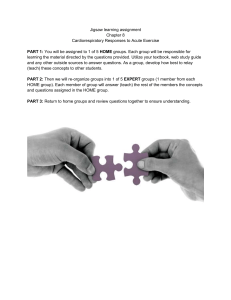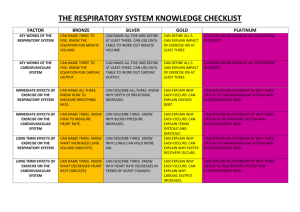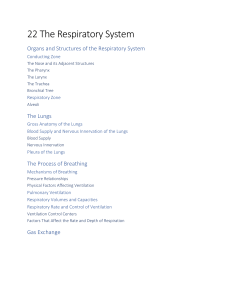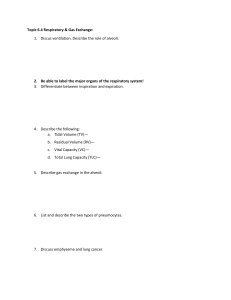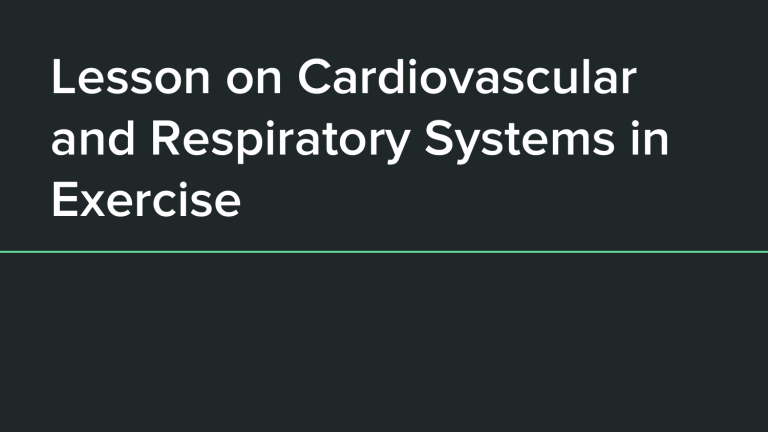
Lesson on Cardiovascular and Respiratory Systems in Exercise Agenda ● ● ● ● ● ● ● ● ● ● ● ● Introduction Cardiovascular System Effects of Exercise on Heart Rate Effects of Exercise on Stroke Volume Effects of Exercise on Cardiac Output Effects of Exercise on Blood Pressure Long-Term Effects of Exercise on Blood Pressure Respiratory System Ventilation During Exercise Minute Ventilation Gaseous Exchange During Exercise Anticipatory Rise 2 Introduction Introduction, Purpose of the Lesson ● ● Understanding the Cardiovascular System: The cardiovascular system consists of the heart, blood vessels, and blood. It is responsible for transporting nutrients, oxygen, and waste products throughout the body. Purpose of the Lesson: The purpose of this lesson is to explore the effects of exercise on the cardiovascular and respiratory systems. We will delve into the changes that occur in heart rate, stroke volume, cardiac output, and blood pressure during exercise, as well as the long-term impact of exercise on blood pressure. Additionally, we will examine the respiratory system and its response to exercise, including ventilation, minute ventilation, and gaseous exchange. 3 Cardiovascular System Overview of Cardiovascular System, Structure and Function of the Heart ● ● Function of the Cardiovascular System: The cardiovascular system maintains blood flow to deliver oxygen and nutrients to tissues, remove waste products, and regulate body temperature. It also plays a vital role in maintaining homeostasis. Structure and Function of the Heart: The heart is a muscular organ composed of four chambers: two atria and two ventricles. Each chamber has specific functions in the circulation of blood. The cardiac muscle contracts rhythmically to propel blood through the circulatory system. Photo by Ali Hajiluyi on Unsplash 4 Effects of Exercise on Heart Rate Heart Rate, Resting Heart Rate, Maximal Heart Rate, Relationship with Exercise Intensity ● Heart Rate and Exercise: Heart rate refers to the number of times the heart beats per minute. Resting heart rate is the heart rate when the body is at rest, while maximal heart rate is the highest heart rate an individual can achieve during exercise. The relationship between exercise intensity and heart rate is linear, with heart rate increasing as exercise intensity rises. Photo by Nathan Dumlao on Unsplash 5 Effects of Exercise on Stroke Volume Stroke Volume, Preload, Afterload, Relationship with Exercise Intensity ● Stroke Volume and Exercise: Stroke volume refers to the amount of blood ejected from the left ventricle of the heart with each contraction. It is influenced by preload, which is the volume of blood in the ventricle before contraction, and afterload, which is the resistance the heart must overcome to eject blood. Stroke volume increases with exercise intensity due to an increase in preload and contractility. Photo by Robina Weermeijer on Unsplash 6 Effects of Exercise on Cardiac Output Cardiac Output, Calculation, Relationship with Heart Rate and Stroke Volume ● Calculating Cardiac Output: Cardiac output is the amount of blood pumped by the heart in one minute. It is calculated by multiplying the heart rate by the stroke volume. During exercise, cardiac output increases due to the combined effect of an elevated heart rate and increased stroke volume. Photo by Natanael Melchor on Unsplash 7 Effects of Exercise on Blood Pressure Blood Pressure, Systolic Pressure, Diastolic Pressure, Relationship with Exercise Intensity ● Blood Pressure and Exercise: Blood pressure is the force exerted by blood against the walls of the arteries. It is expressed as systolic pressure (during ventricular contraction) over diastolic pressure (during ventricular relaxation). Blood pressure increases with exercise intensity as a result of the increased demand for oxygen and nutrients by the muscles. Photo by Mufid Majnun on Unsplash 8 Long-Term Effects of Exercise on Blood Pressure Hypertension, Reduced Resting Blood Pressure, Improved Endothelial Function ● Impact of Exercise on Blood Pressure: Regular exercise is associated with a reduction in resting blood pressure and improved endothelial function, which supports healthy blood vessel function and reduces the risk of hypertension. These long-term adaptations contribute to overall cardiovascular health and reduce the risk of cardiovascular disease. Photo by jesse orrico on Unsplash 9 Respiratory System Overview of Respiratory System, Structure and Function of the Lungs ● ● Function of the Respiratory System: The respiratory system consists of the airways, lungs, and respiratory muscles. Its primary function is to facilitate the exchange of oxygen and carbon dioxide between the external environment and the body's internal tissues. Structure and Function of the Lungs: The lungs are the primary organs of respiration, responsible for the exchange of gases. They consist of bronchi, bronchioles, and alveoli, where gas exchange occurs between the air and the blood. Additionally, respiratory muscles, such as the diaphragm and intercostal muscles, facilitate breathing. Photo by Robina Weermeijer on Unsplash 10 Ventilation During Exercise Ventilation, Tidal Volume, Frequency, Relationship with Exercise Intensity ● Ventilation and Exercise: Ventilation refers to the volume of air moved in and out of the lungs per minute. Tidal volume is the volume of air inhaled and exhaled with each breath, and frequency is the number of breaths taken per minute. During exercise, ventilation increases to meet the elevated oxygen demand, with an increase in both tidal volume and frequency. 11 Minute Ventilation Minute Ventilation, Calculation, Relationship with Tidal Volume and Frequency ● Calculating Minute Ventilation: Minute ventilation represents the total volume of air moved in and out of the lungs in one minute. It is calculated by multiplying tidal volume by breathing frequency. During exercise, minute ventilation increases due to the coordinated rise in tidal volume and breathing frequency. Photo by Sincerely Media on Unsplash 12 Gaseous Exchange During Exercise Gas Exchange in Alveoli, Diffusion, Oxygen Uptake, Carbon Dioxide Removal ● Gaseous Exchange and Exercise: Gaseous exchange occurs in the alveoli of the lungs, where oxygen is taken up by the blood and carbon dioxide is removed from the blood. Diffusion facilitates the exchange of gases, supporting the uptake of oxygen by the body's tissues and the removal of carbon dioxide produced during metabolism. Photo by Brett Jordan on Unsplash 13 Anticipatory Rise Anticipatory Rise, Neural and Hormonal Factors, Preparation for Exercise ● Anticipatory Rise During Exercise: The anticipatory rise involves the increase in ventilation and heart rate that occurs in anticipation of physical activity. It is influenced by neural signals and hormonal factors, such as the release of adrenaline, preparing the body for the upcoming exertion by increasing oxygen availability and blood flow to working muscles. 14
